Related Research Articles

The Holy Roman Empire was a political entity in Western, Central, and Southern Europe that developed in the Early Middle Ages and continued until its dissolution in 1806 during the Napoleonic Wars.
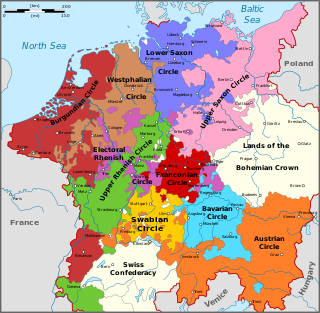
During the early modern period, the Holy Roman Empire was divided into imperial circles, administrative groupings whose primary purposes were the organization of common defensive structure and the collection of imperial taxes. They were also used as a means of organization within the Imperial Diet and the Imperial Chamber Court. Each circle had a circle diet, although not every member of the circle diet would hold membership of the Imperial Diet as well.

Imperial Reform is the name given to repeated attempts in the 15th and 16th centuries to adapt the structure and the constitutional order of the Holy Roman Empire to the requirements of the early modern state and to give it a unified government under either the Imperial Estates or the emperor's supremacy.

The Swabian League was a mutual defence and peace keeping association of Imperial Estates – free Imperial cities, prelates, principalities and knights – principally in the territory of the early medieval stem duchy of Swabia established on 14 February 1488.

The Aulic Council was one of the two supreme courts of the Holy Roman Empire, the other being the Imperial Chamber Court. It had not only concurrent jurisdiction with the latter court, but in many cases exclusive jurisdiction, in all feudal processes, and in criminal affairs, over the immediate feudatories of the Emperor and in affairs which concerned the Imperial Government. The seat of the Aulic Council was at the Hofburg residence of the Habsburg emperors in Vienna.
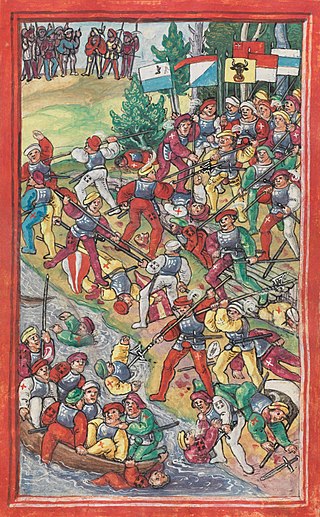
The Swabian War of 1499 was the last major armed conflict between the Old Swiss Confederacy and the House of Habsburg. What had begun as a local conflict over the control of the Val Müstair and the Umbrail Pass in the Grisons soon got out of hand when both parties called upon their allies for help; the Habsburgs demanding the support of the Swabian League, while the Federation of the Three Leagues of the Grisons turning to the Swiss Eidgenossenschaft. Hostilities quickly spread from the Grisons through the Rhine valley to Lake Constance and even to the Sundgau in southern Alsace, the westernmost part of the Habsburg region of Further Austria.
Perpetual Peace or Eternal Peace may refer to:
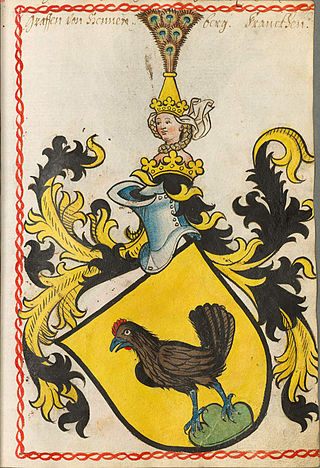
Bertold von Henneberg-Römhild (1442–1504) was Archbishop of Mainz and Prince-elector of the Holy Roman Empire from 1484, imperial chancellor from 1486, and leader of the reform faction within the Empire.

The Imperial Diet was the deliberative body of the Holy Roman Empire. It was not a legislative body in the contemporary sense; its members envisioned it more like a central forum where it was more important to negotiate than to decide.

A Hoftag was the name given to an informal and irregular assembly convened by the King of the Romans, the Holy Roman Emperor or one of the Princes of the Empire, with selected chief princes within the empire. Early scholarship also refers to these meetings as imperial diets (Reichstage), even though these gatherings were not really about the empire in general, but with matters concerning their individual rulers. In fact, the legal institution of the imperial diet appeared much later.

At the Diet of Wormsin 1495, the foundation stone was laid for a comprehensive reform (Reichsreform) of the Holy Roman Empire. Even though several elements of the reforms agreed by the Imperial Diet (Reichstag) at Worms did not last, they were nevertheless highly significant in the further development of the empire. They were intended to alter its structure and constitutional ordinances in order to resolve the problems of imperial government that had become evident.
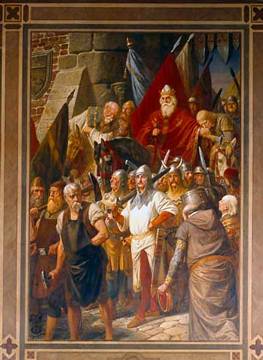
Under the law of the Holy Roman Empire, a Landfrieden or Landfriede was a contractual waiver of the use of legitimate force, by rulers of specified territories, to assert their own legal claims. This especially affected the right of feuding.
Circle troops were the contingents of soldiers that the Imperial Circles (Reichskreise) actually placed at the disposal of the Army of the Holy Roman Empire or Reichsarmee. Following the Imperial Defence Order (Reichsdefensionalordnung) all imperial circles in the empire were obliged to provide contingents of troops, although not all did so in the event. The Imperial Register (Reichsmatrikel) laid down how many troops the individual Imperial States had to make available to the Reichsarmee.
The Imperial Military Constitution was the collection of military laws of the Holy Roman Empire. Like the rest of the imperial constitution, it grew out of various laws and governed the establishment of military forces within the Empire. It was the basis for the establishment of the Army of the Holy Roman Empire, which was under the supreme command of the Emperor but was distinct from his Imperial Army, as it could only be deployed by the Imperial Diet. The last Imperial Defence Order (Reichsdefensionalordnung), entitled Reichsgutachten in puncto securitatis, of 13/23 May 1681, completed the military constitution of the Holy Roman Empire.
The Circle Colonel was an office in the Imperial Circles of the Holy Roman Empire of the German Nation in the Early Modern Period.

Lorenz Hubert Weinrich is a German historian.

The Eltz Feud was a 14th-century feud that arose between rulers of the Trier region on the Moselle and certain members of the knightly class who were acting independently and failing to support their sovereign princes. It came about as a result of attempts in 1331 by the Archbishop of Trier and Elector Baldwin of Luxembourg to re-incorporate the imperial ministeriales or knights of the castles of Ehrenburg, Eltz, Schöneck and Waldeck as vassals into the administrative district of Trier and to subordinate them to a unified, sovereign state administrative structure. Their distance from the power of the imperial government and a weak predecessor of Archbishop Baldwin had allowed the knights to acquire autonomy and rights supposedly under the law of custom, even though they were already vassals and fief holders of the Archbishop.
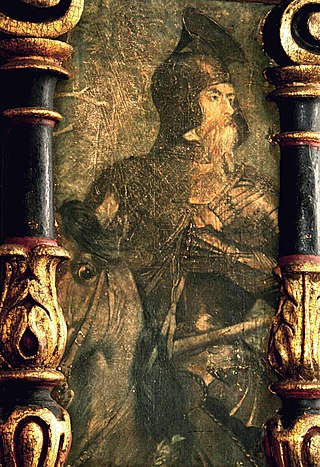
The Franconian War was waged in 1523 when the Swabian League attacked several robber baron castles in Franconia, whose nobles were supporters of Hans Thomas of Absberg in the Absberg Feud.

The Council of Würzburg, also called the Synod of Würzburg or Diet of Würzburg, was a simultaneous church council and royal diet held in Würzburg in March 1287.
References
- ↑ Edward Wigglesworth, Thomas Gamaliel Bradford (1840). Encyclopædia Americana: a popular dictionary of arts, sciences ..., Volume 13, Thomas Cowperthwaite, Philadelphia, p. 65.
- ↑ Christopher Allmand (ed.) (1998). The New Cambridge Medieval History: Volume 7, c.1415-c.1500, CUP, p. 359. ISBN 978-0-521-38296-0
- ↑ Diet of Worms at www.britannica.com. Accessed on 1 Dec 12.
- ↑ W. H. Jackson (1994). Chivalry in Twelfth Century Germany: The Works of Hartmann Von Aue, D.S. Brewer, Cambridge, p. 88. ISBN 978-0-85991-431-4.
- ↑ Theodore Ziolkowski (1997). The Mirror of Justice: Literary Reflections of Legal Crises, Princeton University Press, Princeton, p. 71. ISBN 978-0-691-11470-5.
- ↑ Der Ewige Landfriede vom 7. August 1495 Archived 2016-03-04 at the Wayback Machine . Translation of the Act into Early New High German by Ralph Glücksmann. Retrieved 26 Oct 2013
- ↑ Der Ewige Landfriede von 1495 at www.wasistwas.de. Retrieved 26 Oct 2013
- ↑ History of the Literary Cultures of East-Central Europe: Types and stereotypes edited by Marcel Cornis-Pope, John Neubauer, Amsterdam: John Benjamins, 2004, p. 411.